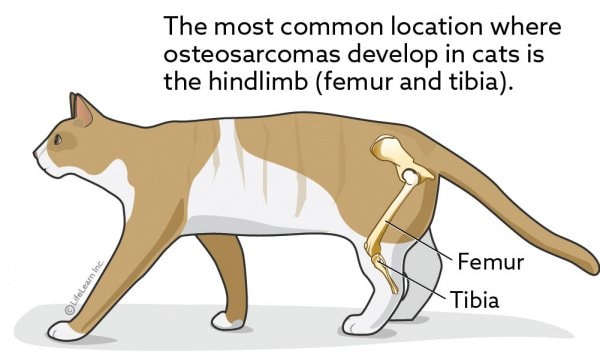Osteosarcoma is the most frequently reported primary bone tumor in cats. The majority of osteosarcomas originate in the metaphyses of long bones, with a higher frequency in the forelimbs. Solitary osteolytic metaphyseal long bone lesions in older cats are considered osteosarcoma until proven; otherwise, these lesions tend to be less aggressive than canine osteosarcoma.
Important Information on Osteosarcoma in Cats
Cats suffer from both infectious and non-infectious diseases. It is a malignant tumor of the bone of your cats. The disease can occur in any bone in your pet’s body. The most commonly affected bones are the long bones of the legs, through bones such as the skull, pelvis, ribs, or vertebrae may also be affected. It is called extraskeletal osteosarcoma.

What Cause Osteosarcoma in Cats?
The cause is unknown. However, the association of osteosarcoma with metaphyseal bone suggests that neoplastic transformation may result from aberrant bone growth or differentiation.
Symptoms of Osteosarcoma in Cats
It is an excruciating condition, and the symptoms include:
- Tumors are most prevalent away from the elbow and around the stifle.
- Swelling and lameness of the affected limb.
- Swelling may or may not involve soft tissue.
- The tumor is seen arising on the outer surface of the cortex of the humerus, femur, frontal bones, and ramus of the mandible.
- Owing to the onset of swelling and pain, a non-neoplastic orthopedic problem can be mistakenly assumed.
- Loss of appetite, lethargy, and weight loss.
- Seizures or a wobbly gait with the skull or spinal/vertebral tumors.
- Breathing difficulties.
- Weakness.
How is Osteosarcoma Diagnosed?
The main diagnostic tests for osteosarcoma are radiographs, which may reveal Codman’s triangle and the proliferative or lytic pattern of the metaphyseal bone region. If your veterinarian considered the treatment and the extent of disease metastasis should be determined by a radiographic survey of the thorax or skeleton. A small percentage (5-10%) of affected animals has detectable lung lesions. In case of a doubtful area is seen, in this situation, a fine-needle aspirate or biopsy of bone tissues to be performed to make a final diagnosis.

Differential Diagnosis of Feline Osteosarcoma
The disease may be confused with:
- Metastatic lesion.
- Other Primary bone tumors.
- Osteomyelitis.

Treatment of Osteosarcoma in Cats
Treatment of osteosarcoma depends on your veterinarian’s choice. The vets may choose the wide surgical excision or amputation as the treatment of choice. The tumor proliferates, and Cisplatin, the chemotherapy, is another choice for the treatment of osteosarcoma. Osteosarcoma in cats is less aggressive, and amputation alone yields a median survival of >4 years. Since osteosarcoma is often associated with considerable pain, management with NSAIDs may be appropriate for your pets. Furthermore, there is some speculation that COX-2-specific NSAIDs manifest antitumors mechanisms.